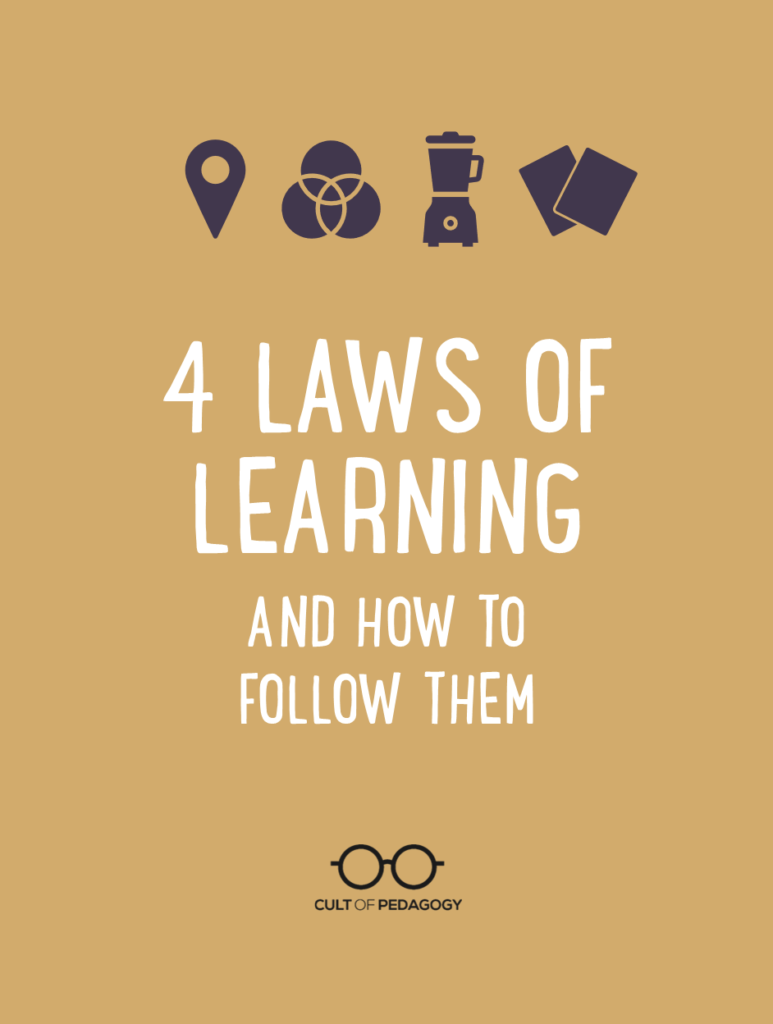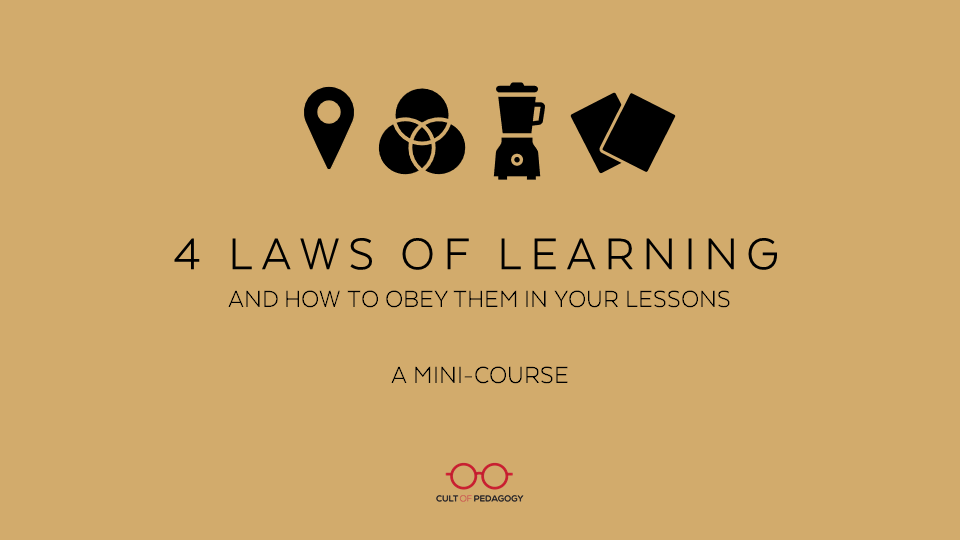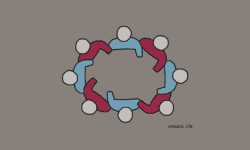
Listen to this post as a podcast:
Sponsored by Pear Deck and UL Xplorlabs
Teaching is a complex, multifaceted, dynamic profession. New ideas, new tools, and new strategies are coming at you all the time. On top of that, changing circumstances compel you to make adjustments to the way you normally do things.
With all of this spinning around you, it can be hard to find a clear path. There are so many factors that impact student learning, but when it comes to planning lessons—that 45- to 90-minute block of time set aside for instruction—what activities really move the needle on learning? To make those instructional decisions, it helps to have a compass, a set of principles you can return to again and again when you start to feel like you’re losing your way.
That’s what I have for you here: I looked at the research and managed to condense what I found into four “Laws of Learning,” broad guidelines that define solid teaching practices.
I’m certainly not the first person to do this: John Hattie’s work to rank various influences on student achievement has been groundbreaking, but I have often felt confused about what some of his terms actually mean. Plus, every time I mention him, I’m met with fierce pushback from people whose understanding of statistics is way more sophisticated than mine. There’s also Robert Marzano’s high-yield strategies, which I’m a big fan of, but I’ve learned a few things over the last few years that aren’t covered by those.
So here I’m offering my own list, shorter than Marzano’s, a LOT shorter than Hattie’s, and not nearly as comprehensive. But they’re good. And they’re backed by research. I’m not putting these out there as THE four laws. They are not the last word on teaching or the only thing you should ever consider when planning a lesson. But they’re heavy hitters, and if you find yourself feeling unsure about how to choose between all the different approaches and tools, returning to these four principles will absolutely put you on solid ground.
Law 1: Keep the GPS On
When we go on a trip, many of us use GPS navigation systems, which give us precise information about the route we should follow and how long it will take to get there. These systems give us constant updates along the way, so we always know how much progress we’re making.
As teachers, whether or not we provide instructional “GPS” can make a huge difference in how well our students learn. For best results, our instructional GPS should be on in these ways:
Learning Goals and Success Criteria: It’s vital to regularly communicate these so students know exactly where they are headed and what it will look like when they reach the goal. Multiple studies report that achievement increases significantly when students understand the learning goals and the criteria for success. (Dean et al., 2012).
- Write goals in age-appropriate language and refer to them before, during, and after lessons.
- Use rubrics to spell out success criteria. Single-point rubrics work especially well for complex assignments.
- Provide models of different levels of success, so students get a clear picture of finished products.
Formative Assessment: Improving formative assessment leads to learning improvements for all students and reduces gaps between low- and high-achievers (Black & Wiliam, 1998).
- Make formative assessment truly formative. It’s a measurement tool that shouldn’t count against a student’s grade. Check formative assessments quickly after they are given and use them to make instructional decisions.
- Conduct formative assessment in different ways: quizzes, exit slips, class polls, and think-pair-shares are all ways to formatively assess student understanding.
Effective Feedback: Feedback is most effective when it draws attention to positive elements of student performance, addresses the success criteria, includes specific advice on improvement, is presented in small, manageable units, and is given soon after the student attempts the task (Australian Institute for Teaching and School Leadership, 2017; Shute, 2008).
- Using Flash Feedback techniques like targeted response and microconferences allows you to give more feedback more efficiently.
- Learning improves most when students are given feedback without grades (Black & Wiliam, 1998). A strategy like Kristy Louden’s Delaying the Grade allows students to focus on and learn from feedback before they receive grades.
Law 2: Classify, Connect, and Compare
As we learn, our brains are wired to group things into categories (Bruner, 1973; Jensen, 1998). When new information comes in, we sort it, compare it, and try to make sense of it based on similar characteristics. If we can work with this natural tendency in our teaching, we will boost student learning.
These strategies put this law into practice:
Concept Attainment: This strategy has students study Yes and No examples of a concept until they can begin to define that concept, then refine their definition by looking at more examples. Learn more about Concept Attainment here.
Graphic Organizers: Using these naturally gets students to classify, compare, and make connections between concepts. For graphic organizers to work best, teachers should explain their purpose, model their use, and for complex material, partially complete them (Hall & Strangman, 2002). Learn more about graphic organizers here.
Inductive Learning: This strategy has students group chunks of content into categories and label the categories prior to learning about a new topic. Once their minds are primed from doing this work, they are then presented with the content in a more traditional way. Learn more about Inductive Learning here.
Law 3: To Learn, We Need to Churn
Between the time when we introduce skills and knowledge to students and the time when we assess their mastery of those skills and knowledge, they need to process that material in some way.
Some lesson plans call this processing guided practice or independent practice, and these terms make sense if we’re talking about skills. They are less logical with knowledge-based content, because you can’t “practice” information, but students still need to interact in some way with the material they learn.
To cover all bases, we’ll use the term churn, the act of agitating or breaking something up (like liquid in a blender). If we want students to learn something well, we need to give them an opportunity to churn that material up.
Here are just a few ways to add churn to your lessons:
Movement: Adding gestures to learning activities results in more enduring learning (Cook et al., 2010), and physical activity is correlated with improved academic performance (Donnelly & Lambourne, 2011). This post covers many different ways to add movement to instruction.
Note-Taking: A lot of research supports the use of note-taking to boost learning (summarized here). Look for opportunities to add note-taking to your instruction.
Cooperative Learning: Having students work cooperatively consistently yields higher levels of achievement than either competitive or independent learning (Johnson, Johnson, & Holubec, 1994). Some great cooperative learning strategies are Jigsaw, Reciprocal Learning, and Chat Stations.
Law 4: Better to Retrieve than Receive
In so many teaching situations, our instinct is often to push information into students’ brains. And although it is absolutely necessary for students to take in the material in order to learn it, and to “churn” it as we covered in Law 3, once the information has been delivered and processed, there are other things we can do to make sure that information is locked into long-term memory.
When it’s time to study our material—to review it for a test, for example—what many teachers and students tend to do is simply re-read it. Teachers prepare study guides with bulleted lists or study concepts, and students review their notes or readings.
A much more effective approach to studying is retrieval practice. Retrieval practice is the act of recalling information without the aid of a text; in other words, quizzing ourselves on the material. The more we can build retrieval practice into our instruction, the better our students will get at recalling the information and concepts we’re trying to teach them. (Learn more here.)
Here are some ways to add retrieval practice to your classroom:
- Low-Stakes Quizzes: Give students regular quizzes on your course content. Because these quizzes are meant to be practice, they should either be ungraded or given a minimal amount of points.
- Flashcards: Teach students how to create and study flashcards, then set aside class time for them to study.
- Brain Dumps: Give students a few minutes to write down everything they can remember about a topic they’ve learned in your class, then let them check their response for accuracy and completeness with the text, a classmate, or both.
Go Deeper
My online mini-course, 4 Laws of Learning, is a self-paced course that helps you really learn these principles and apply them to your teaching.

Here’s what the course includes:
- Four video-based modules, one for each law, with detailed explanations of specific strategies for implementing the law in your practice
- More research to support each of the four laws
- Guided notes you can work with while you watch the modules
- A quiz after each module to check your understanding
- A reflection at the end of each module to help you make specific plans for applying the laws in your own teaching
- A tools for remote learning feature that lists tools you can use to apply each law in remote teaching situations
- A 22-page PDF of summary notes that includes all the key points from the course and a full bibliography of the research.
The course is available to single users, groups of five or ten, or a whole-school license if you want it for every teacher in your building. Learn more about the course here.
References
Australian Institute for Teaching and School Leadership. (2017). Spotlight: Reframing feedback to improve teaching and learning. https://www.aitsl.edu.au/docs/default-source/research-evidence/spotlight/spotlight-feedback.pdf
Black, P., & Wiliam, D. (1998, October 1). Inside the black box: Raising standards through classroom assessment. Phi Delta Kappan Online. https://kappanonline.org/inside-the-black-box-raising-standards-through-classroom-assessment/
Bruner, J. (1973). Beyond the information given: Studies in the psychology of knowing. W.W. Norton.
Cook, S. W., Yip, T. K., & Goldin-Meadow, S. (2010). Gesturing makes memories that last. Journal of memory and language, 63(4), 465-475.
Dean, C. B., Hubbell, E. R., Pitler, H., & Stone, B. (2012). Setting Objectives and Providing Feedback. ASCD. http://www.ascd.org/publications/books/111001/chapters/Setting-Objectives-and-Providing-Feedback.aspx
Donnelly, J. E., & Lambourne, K. (2011). Classroom-based physical activity, cognition, and academic achievement. Preventive Medicine, 52, S36-S42.
Jensen, E. (1998). Teaching with the brain in mind. ASCD.
Johnson, D.W., Johnson, R.T., & Holubec, E.J. (1994). New circles of learning: Cooperation in the classroom and school. ASCD.
Shute, V. J. (2008). Focus on formative feedback. Review of Educational Research, 78(1), 153–189. http://myweb.fsu.edu/vshute/pdf/shute%202008_b.pdf
Join our mailing list and get weekly tips, tools, and inspiration that will make your teaching more effective and fun. You’ll get access to our members-only library of free downloads, including 20 Ways to Cut Your Grading Time in Half, the e-booklet that has helped thousands of teachers save time on grading. Over 50,000 teachers have already joined—come on in.





I don’t think that the podcast on this page matches the rest of the page.
Hey Suzanna. Thanks so much for the heads up – it’s fixed!
Hi Jennifer,
thanks for the article and for the podcast. A have a question: how often can I use quizzes in class? I want to add something new to my lessons, but I’m afraid to overdo it.
Thanks!
Hi Emily,
There really isn’t any hard fast rule as to how often you can give a quiz – I think it really comes down to being intentional. Frequent formative assessments (which don’t always need to be a quiz) will help you make important instructional decisions. You might find out that some kids need review, some may need more practice, and others may benefit from reteaching via different teaching strategy. As mentioned in the article, retrieval practice of content, which can be a low stakes quiz, can really help learning stick. You can give those any time you want kids to practice something. Rather than adding a quiz in order to add something new to a lesson, make sure you know why you’re giving the quiz. Will you be using the data to inform your instruction? Will it inform and provide students practice? Those are the things I’d take into account. You might give an exit slip one day and a low stakes quiz the next day on something that was taught a few days earlier. As long as you know why you’re giving the quiz, don’t worry about overdoing it.
If you haven’t already looked into it and are wanting to go a bit deeper, check out Jenn’s 4 Laws of Learning course. Hope this helps!
Fantastic episode. I struggle with the “church” element in teaching. Thanks for giving great ideas of how students can really break down and practice new concepts.
Thanks for the wonderful work of equipping us as we seek to improve the craft of teaching 🙂
Thank you so much for the information and for your research, it is nicely structured and interesting!
Great article, Jennifer. Thanks for sharing!
The 4 Law of Learning helps teachers keep the focus of what is truly important in the middle of chaos. I have shared it widely with my teacher friends. I keep coming back to it when the noise tries to drown out what we know works in the classroom. Thank you!
For me, my guiding constellation after teaching 10 yrs and never feeling like i knew in what ways i should teach… I’ve now found my guidance with these principals/strategies(in no particular order): cognitive load theory, Rosenshine principals of instruction(much stuff), retrieval, spacing, dual coding, and Content Enhancement Routines(these are awesome!)
Also dylan wiliam, formative assessment.
I also touch base with Hattie, “Visible Learning”.
After spending some years reading research/studies and trying to figure-out my profession, I finally feel less stressed about my sources of information for pedagogy….which is a relief 🙂
1 out of 4 kids has an unseen disability. They are in every classroom, diagnosed or not. How does this work with kids who have learning disabilities, attention problems, or autism? Seems like the principles could work. I would love to hear some specifics.
Thank you for all of the information and tips you packed into this article. I especially appreciate the section that includes retrieval. I’ve been trying to use it more and more with my 8th-grade students.
I’ll include a link to this article in my next newsletter.
I agree with everything but the first point. While we need to keep learning goals in mind, the obsession with assessment has gotten ridiculous to the point of stripping elements out of every other aspect of teaching.
The inclusion of the terms “Learning Goals/Success Criteria” is just maddening as too many admins thinks that these are all education is. They insist that actual teachers spend a stupid amount of time wordsmithing this waste of time and not doing other important tasks. It is the admin groupthink version of masterbation, has almost no effect on actual teaching and drains the time out of already busy schedules. We dont care what YOU think a classroom should look like, teachers are experts, let them teach.
Matt,
As a teacher, I agree that lack of planning and instructional time is extremely frustrating. And like many teachers, I often lose instructional time to test prep and the administration of standardized tests. And it’s always hard to sit in data meetings on my prep when I know I could be using that time for planning lessons. That being said, I recognize data collection on the classroom level is an essential part of my practice. I believe it’s important for us to make sure our students understand the material and are making progress towards mastery of the standards. Assessments and assessment criteria such as rubrics and checklists are simply our tools for doing so.
Jenn actually has a great interview with Starr Sackstein called “Build it Together: Co-Constructing Success Criteria with Students” that you might find relevant to this conversation. Feel free to share with your admin if you think it would be helpful. As with so many things, if we do them with intention and care, we find that they are worth our time.
I support this information.